Life sciences research constantly evolves due to technological advancements and collaboration across disciplines. Over the next decade, key trends like AI, telemedicine, and gene editing will drive innovation to improve quality of life. However, ethical concerns and regulatory changes will continue to play a significant role in shaping the future of these technologies.
B2B companies in the life sciences must understand the relationship between innovation and regulatory change for successful growth, compliance, and long-term impact in the industry. This article examines ten key life science research trends and the ethical considerations shaping them.
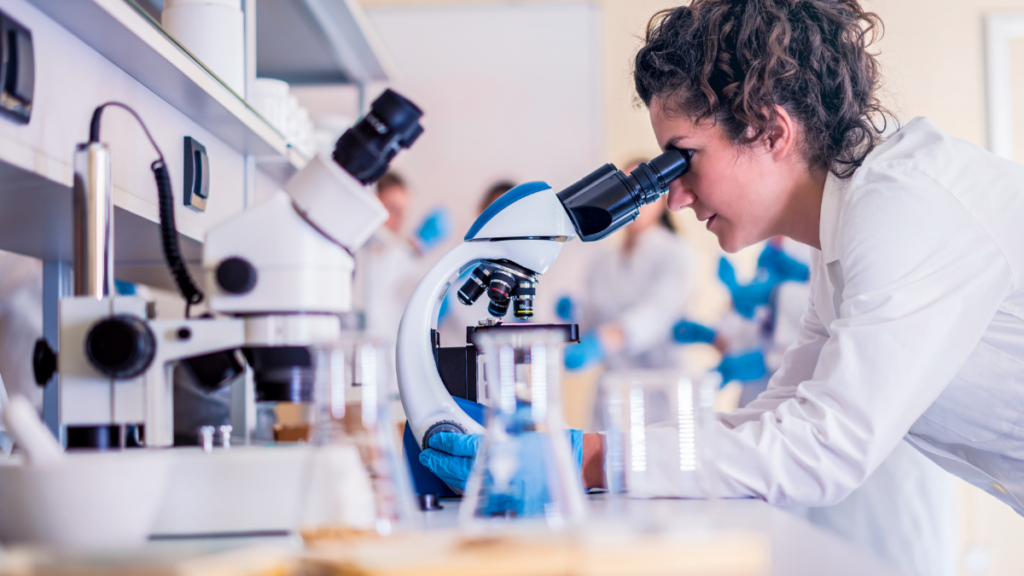
10 Trends in Life Sciences Research for the Coming Decade
Integration of Advanced Data Analytics and AI
Advanced data analytics and AI are transforming the life sciences industry, with the market expected to reach $45.2 billion by 2026. Through machine learning and predictive analytics, AI is revolutionizing healthcare solutions by extracting valuable insights from data and automation. These technologies accelerate biopharma operations, enhance disease modeling through compound screening, and streamline drug discovery.
An example of this is Google DeepMind. This AI technology has revolutionized protein structure prediction, an important milestone in drug development. Through protein structure prediction, scientists can develop drugs that will target specific proteins. These are often linked to such conditions as Parkinson’s disease. This discovery has created opportunities in drug development.
The Emergence of Personalized Medicine
Personalized medicine represents a major advancement in AI-driven healthcare, with the industry valued at $538.93 billion and continuing to grow. This approach tailors healthcare to the individual, leveraging breakthroughs in genomics, biometrics, and molecular diagnostics. By considering a person’s genetics, environment, and lifestyle, personalized medicine aims to deliver precise treatments at the right time—ranging from customized treatment plans to early intervention through predictive analytics.
Recent Developments
Another significant development in personal medicine is the integration of data into electronic health records (EHRs). This combination has created new opportunities for research and implementation in personalized medicine. The widespread adoption of EHRs in clinical settings has made personalized care more feasible, especially with population-based biobanks now linked to EHRs.
The Strength of Collaborative Life Sciences Research
The shift towards personalized diagnosis and treatment does not only depend on technological breakthroughs. Despite all the difficulties, the triumph of models demonstrates that unified scientific efforts can be successful.
Recent collaboration between various companies has shown that collaborative work has power. Specialists can provide their knowledge and open-access platforms for faster innovation. Industry consortiums and pre-competitive public-private partnerships bring together diverse perspectives and resources from multiple institutions, helping to overcome various challenges. By pooling these resources, they can act as stepping stones for developing effective global solutions.
The Surge in Biotech Startups and Funding
The collaborative spirit driving the growth of start-ups is reflected in the significant investment flowing into the sector. Research and development expenditure in biotechnology reached $244 billion in 2020, highlighting the immense potential of biotech innovations. Innovative start-ups are addressing serious medical challenges, but translating these breakthroughs into commercial success requires a blend of business acumen, strategic risk-taking, and scientific expertise. Sustaining growth also demands operational scaling, along with simplified regulations and global market strategies.
The Focus on Sustainable and Ethical Practices
Leading institutions in the life sciences are increasingly prioritizing sustainable and ethical practices. This shift recognizes the significant impact that research and development have on society and the environment. As the industry evolves, there is a stronger focus on incorporating responsible practices, ensuring that advancements are achieved with both integrity and long-term sustainability in mind.
Prominent institutions are achieving the following objectives:
- Enhancing laboratory processes
- Preserving resources
- Mitigating emissions
- Encouraging transparency by adopting ESG practices and cleaner value chains
In addition, there are stricter controls to ensure the safety of human subjects. These controls focus on privacy, equity representation, and avoidance of marginalization. Upholding responsibility and moral integrity becomes crucial when exploring and pushing the boundaries of knowledge.
Emerging Trends
Sana Biotechnology; Advancing Cell Therapy Accessibility
Sana Biotechnology is at the forefront of developing strategies for repairing or replacing any cell within the body. Their primary focus lies in creating “stem cells for regenerative medicine applications. This is a new course of action in life sciences research that allows for specific, genetic changes in cells and tissues in vivo; it has promising uses. It can help to address the ethical and logistical obstacles of personalized cell therapies.
Telemedicine and Remote Clinical Trials
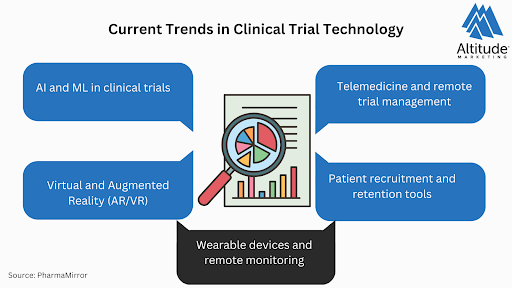
Telemedicine and remote clinical trials have grown rapidly in recent years, driven by the digital world and accelerated by the global pandemic. Virtual healthcare infrastructure became essential to minimize disruptions, making telehealth consultations more popular. These services allow patients to access healthcare while helping clinicians manage their caseloads more efficiently. However, challenges remain, such as ensuring telemedicine is accessible to non-English speakers, highlighting the need for more inclusive healthcare technologies.
Remote research can also be conducted through decentralized clinical trials, which use tools and services that are accessible remotely. These trials expand the reach of research and accelerate scientific progress. However, ensuring data integrity and privacy is crucial for the success of these trials.
Remote patient monitoring has proven effective in managing chronic diseases. By using telemedicine and digital health technologies, researchers can track patients from a distance. This approach is especially beneficial for conditions like diabetes, which require ongoing monitoring.
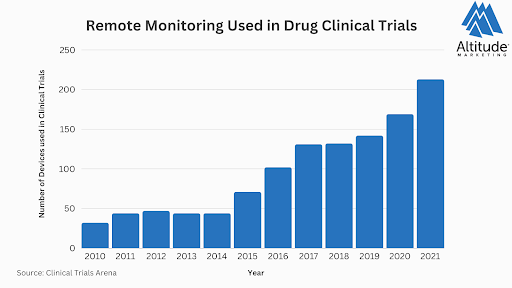
Breakthroughs in Gene Editing
A major advancement in the field of gene editing is the development of CRISPR/Cas9 technology. This revolutionary tool has overcome many limitations of earlier gene modification techniques, with its molecular “scissors” offering a more effective way to alter DNA sequences. While this opens up new possibilities, challenges related to efficacy and safety continue to hinder its widespread clinical use. Additionally, ethical concerns arise from the potential to alter cells in ways that could have far-reaching consequences. Despite these issues, there is hope that gene editing could provide a solution for genetic conditions that cause severe disabilities.
Thanks to technologies like CRISPR/Cas9, scientists have made significant strides in editing genetic material. Ongoing research and development are making these techniques more efficient, while also identifying potential risks and limitations. Efforts are also focused on improving methods to make gene editing safer and more accurate. These advancements hold promise for treating a variety of conditions, including sickle cell disease, heart disease, and cancer.
Internet of Things (IoT ) and Wearable Technology
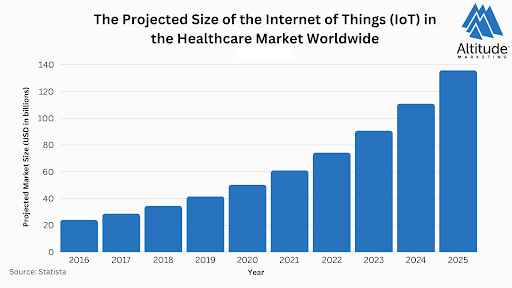
The integration of wearable technologies into the Internet of Medical Things (IoMT) is rapidly advancing in the healthcare sector. By 2025, the market for IoMT is expected to reach $130 billion. The IoMT includes various devices like monitoring units, tablets, and remote sensors that enable real-time health data collection.
Wearable sensors measure biometrics, such as phenotype data, allowing clinicians to monitor detailed physiological information. When combined with cloud analytics and AI, these technologies can aid in the early detection of diseases. As cloud analytics improve, they can provide predictive interventions, helping to identify health risks before they become critical.
In addition, population health data analysis is important for understanding the risks associated with various diseases and available treatments. IoT devices in healthcare collect key health metrics like heart rate, blood pressure, and temperature. While these devices offer significant benefits, data privacy and integrity concerns remain. To address these challenges, healthcare providers are focusing on the following:
- Advancements in security measures
- Interoperability standards
- Data governance
Regulatory and Compliance Evolution
With the adoption of technology, regulating bodies are also adjusting their practices. Recent discussions have focused on modernizing regulations for processing mammography, including improvements to quality assurance processes and better communication with patients. The issue of accountability is also being addressed in other regulations related to AI in healthcare, ensuring responsible use and oversight of these technologies.
These factors are important to consider:
- Ensuring transparency in sourcing data.
- Eliminating biases from the process.
- Evidence of claimed benefits.
Further, as experts study trial models it is vital to revise the digital privacy laws. It is also suggested to keep cybersecurity awareness. Policymakers have to be adaptable and visionary to keep up with the pace of progress.
3D Bioprinting and Tissue Engineering
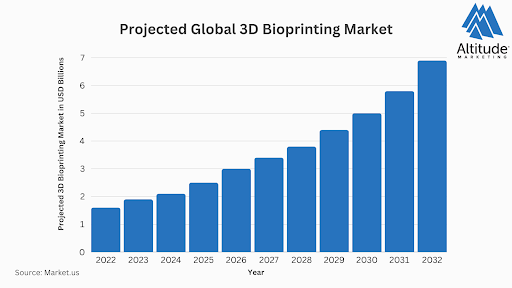
3D bioprinting and tissue engineering are transforming the medical field. These technologies allow for the precise creation of biomaterials and functional tissues through layer-by-layer bioprinting. Currently, they are used for applications like skin grafts and cartilage regeneration, with the potential to one day enable the bioprinting of transplant organs. Additionally, 3D bioprinting allows for the creation of tissue models that closely mimic human physiology, providing valuable tools for testing. This groundbreaking technology has the power to revolutionize organ transplants and tissue repair, marking a significant leap forward in medical science.
Applications of 3D bioprinting currently include:
-
Creating tissue and organ models using biomaterials and living cells. These models form scaffold-like structures that can be used to treat heart disease, cancer, and spinal cord injuries.
-
Supporting drug testing and disease modeling by accurately replicating in-vivo conditions. This helps improve the predictability of clinical effects and drug toxicity.
Looking Ahead to the Future
|
Trends |
Investment Considerations |
Readiness Level |
Key Players |
Best Used in Industry |
|
Advanced Data Analytics and AI |
High – Technology and talent |
Mature |
IBM, Google DeepMind, NVIDIA |
Biopharma, Healthcare IT |
|
Personalized Medicine |
Moderate to High – Technology integration |
Growing |
23andMe, Illumina, Genentech |
Biotechnology, Genomics |
|
Collaborative Research |
Variable – Partnership dependent |
Emerging |
Moderna, Pfizer-BioNTech (COVID-19 Vaccine) |
Pharmaceutical, Academic Research |
|
Biotech Startups and Funding |
High – Venture capital and funding |
Variable |
CRISPR Therapeutics, Moderna |
Biotechnology, Healthcare Startups |
|
Sustainable and Ethical Practices |
Moderate – Sustainable practices |
Growing |
Gilead Sciences, Novartis |
All industries, particularly Pharma |
|
Telemedicine and Remote Trials |
Moderate – Digital infrastructure |
Mature in Telemedicine, Emerging in Trials |
Teladoc Health, Amwell |
Healthcare Providers, Clinical Research |
|
Gene Editing Technologies |
High – R&D investment |
Emerging |
CRISPR Therapeutics, Editas Medicine |
Genetic Research, Therapeutics |
|
IoT and Wearables in Healthcare |
Moderate to High – Device and system investment |
Growing |
Fitbit, Apple (Healthcare Division) |
Healthcare Monitoring, Fitness |
|
Regulatory and Compliance Evolution |
Moderate – Compliance with regulations |
Ongoing |
FDA, EMA and ICH |
All industries, especially Pharma and Biotech |
|
3D Bioprinting and Tissue Engineering |
High – Advanced R&D and materials |
Emerging |
Organovo, BioBots |
Regenerative Medicine, Pharmaceutical Testing |
Considering these trends, it’s clear that the next decade in life sciences research holds numerous opportunities for growth and innovation. As we conclude this article, it’s important to reflect on the challenges and opportunities that lie ahead for companies in this industry.
While there is much optimism, businesses must make strategic investments based on emerging trends and patterns. These investments will yield strong returns for companies that stay informed about ongoing developments and anticipate future changes.
Ready to elevate your B2B marketing?
We help leading business-to-business brands hit their marketing goals. Get in touch to learn how Altitude Marketing can help you reach your peak performance.



